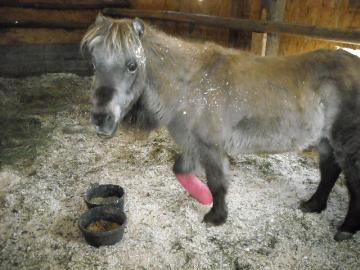Hi,
Just Daphne, a sweet little 28 yr old Miniature Horse mare, broke her fetlock. She was standing on the side of it with her foot flopping to the side when I found her.
We started off splinting her just to make her more comfortable for the last trip to the Vet as they were too busy to come out.
But it appeared she had no intent of leaving this world yet. So, we have been changing her splints and bandages constantly and she has been spared that journey.
Her leg is definitely healing, though not perfectly straight. Due to a bad sore on the outside of her fetlock, from before her splint, we have done two courses of antibiotics and it is a clean looking wound.
It has been 5 weeks now with the splints and I am looking to take them off in a week if I can come up with the right way to support her leg.
I don't give up easily & I am unwilling to have to tell my friend I had to give up on her dear little Daphne. She was brought here for her retirement when my friend had brain cancer & had to give up her farm. I send her frequent pictures and updates and we just aren't ready to let her go.
Has anyone ever dealt with a broken fetlock? My biggest concern is whether the tendons will heal. It felt like top & bottom of her fetlock was broken & her foot was loose like a rag. Now if I hold her leg, it no longer flops. But she has not been allowed yet to put pressure on it without the splints.
With splints on, she gently uses it to paw the stall and her toe rests on the ground. But the splint takes weight as well. Lately she has learned to hop & hold it up. She is pretty agile for a 28 yr old! She is getting daily MSM & glucosomine.
I have a TENS which I bought to rehab Lulu, another injured mini & it really helped. So, I plan to use that to try & help her leg get back in shape once the splints are off.
I purchased a pair of little neoprene splint type boots & am hoping they might help. But I am not sure they will be stiff enough. I thought I could get a few different types of support ready for her & then they can be changed as needed. It will sure help once the sore heals up.
Anyway, it would be helpful to hear from someone who has had success with this type of injury. I'm afraid to talke the splint off in case she needs it. Thanks a bunch.

Just Daphne, a sweet little 28 yr old Miniature Horse mare, broke her fetlock. She was standing on the side of it with her foot flopping to the side when I found her.
We started off splinting her just to make her more comfortable for the last trip to the Vet as they were too busy to come out.
But it appeared she had no intent of leaving this world yet. So, we have been changing her splints and bandages constantly and she has been spared that journey.
Her leg is definitely healing, though not perfectly straight. Due to a bad sore on the outside of her fetlock, from before her splint, we have done two courses of antibiotics and it is a clean looking wound.
It has been 5 weeks now with the splints and I am looking to take them off in a week if I can come up with the right way to support her leg.
I don't give up easily & I am unwilling to have to tell my friend I had to give up on her dear little Daphne. She was brought here for her retirement when my friend had brain cancer & had to give up her farm. I send her frequent pictures and updates and we just aren't ready to let her go.
Has anyone ever dealt with a broken fetlock? My biggest concern is whether the tendons will heal. It felt like top & bottom of her fetlock was broken & her foot was loose like a rag. Now if I hold her leg, it no longer flops. But she has not been allowed yet to put pressure on it without the splints.
With splints on, she gently uses it to paw the stall and her toe rests on the ground. But the splint takes weight as well. Lately she has learned to hop & hold it up. She is pretty agile for a 28 yr old! She is getting daily MSM & glucosomine.
I have a TENS which I bought to rehab Lulu, another injured mini & it really helped. So, I plan to use that to try & help her leg get back in shape once the splints are off.
I purchased a pair of little neoprene splint type boots & am hoping they might help. But I am not sure they will be stiff enough. I thought I could get a few different types of support ready for her & then they can be changed as needed. It will sure help once the sore heals up.
Anyway, it would be helpful to hear from someone who has had success with this type of injury. I'm afraid to talke the splint off in case she needs it. Thanks a bunch.




